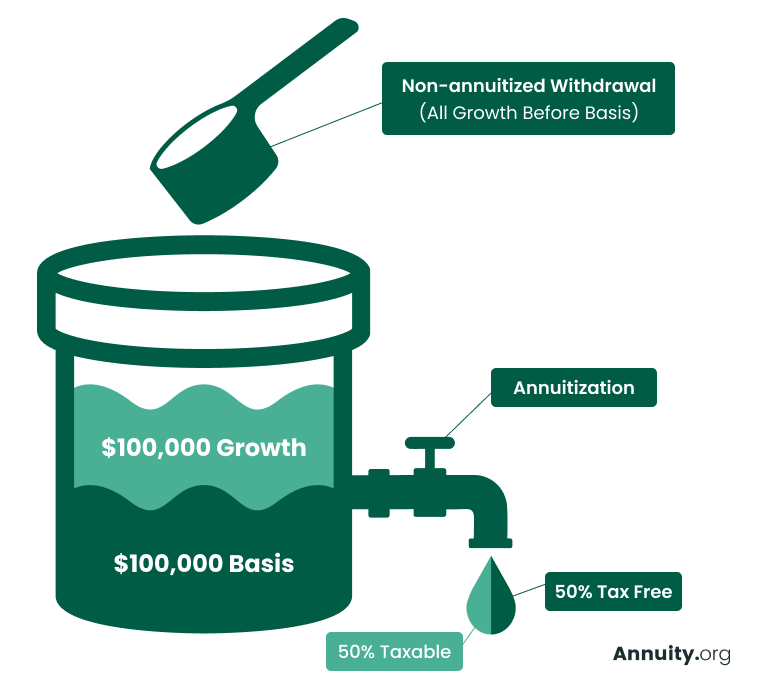All Categories
Featured
Table of Contents
This five-year general regulation and 2 adhering to exemptions apply just when the owner's death sets off the payment. Annuitant-driven payments are reviewed listed below. The very first exemption to the general five-year rule for specific recipients is to approve the survivor benefit over a longer duration, not to go beyond the anticipated life time of the recipient.
If the beneficiary chooses to take the fatality advantages in this method, the advantages are exhausted like any other annuity payments: partly as tax-free return of principal and partly taxed revenue. The exemption proportion is discovered by utilizing the deceased contractholder's price basis and the expected payouts based on the recipient's life span (of much shorter period, if that is what the beneficiary chooses).
In this technique, sometimes called a "stretch annuity", the beneficiary takes a withdrawal every year-- the required quantity of each year's withdrawal is based upon the exact same tables used to calculate the called for distributions from an individual retirement account. There are two benefits to this technique. One, the account is not annuitized so the beneficiary maintains control over the cash value in the contract.
The second exemption to the five-year guideline is offered only to a surviving partner. If the marked beneficiary is the contractholder's partner, the spouse may elect to "tip right into the footwear" of the decedent. In result, the partner is treated as if she or he were the owner of the annuity from its beginning.
Tax rules for inherited Lifetime Annuities
Please note this uses only if the partner is named as a "assigned recipient"; it is not readily available, for instance, if a trust fund is the beneficiary and the partner is the trustee. The basic five-year guideline and both exceptions only put on owner-driven annuities, not annuitant-driven agreements. Annuitant-driven contracts will certainly pay fatality advantages when the annuitant passes away.

For objectives of this conversation, presume that the annuitant and the proprietor are different - Annuity payouts. If the agreement is annuitant-driven and the annuitant passes away, the fatality triggers the survivor benefit and the recipient has 60 days to make a decision just how to take the death benefits based on the regards to the annuity contract
Also note that the choice of a partner to "tip into the shoes" of the owner will not be offered-- that exception uses only when the proprietor has died however the owner really did not pass away in the instance, the annuitant did. Last but not least, if the recipient is under age 59, the "fatality" exception to prevent the 10% penalty will certainly not put on a premature circulation again, because that is available only on the fatality of the contractholder (not the fatality of the annuitant).
Lots of annuity business have inner underwriting plans that refuse to release agreements that name a various owner and annuitant. (There might be strange situations in which an annuitant-driven agreement meets a customers distinct needs, yet usually the tax obligation disadvantages will surpass the advantages - Period certain annuities.) Jointly-owned annuities may pose similar issues-- or at the very least they may not serve the estate planning function that jointly-held possessions do
Consequently, the death advantages need to be paid within five years of the very first owner's death, or subject to the 2 exceptions (annuitization or spousal continuance). If an annuity is held collectively in between a couple it would certainly show up that if one were to die, the other could merely proceed possession under the spousal continuation exemption.
Think that the couple named their kid as beneficiary of their jointly-owned annuity. Upon the death of either proprietor, the company has to pay the fatality advantages to the child, who is the recipient, not the surviving spouse and this would probably beat the owner's objectives. At a minimum, this instance directs out the complexity and unpredictability that jointly-held annuities pose.
Are Joint And Survivor Annuities taxable when inherited
D-Man created: Mon May 20, 2024 3:50 pm Alan S. created: Mon May 20, 2024 2:31 pm D-Man created: Mon May 20, 2024 1:36 pm Thanks. Was really hoping there may be a system like setting up a recipient IRA, but looks like they is not the case when the estate is arrangement as a recipient.

That does not identify the kind of account holding the inherited annuity. If the annuity remained in an acquired individual retirement account annuity, you as administrator ought to have the ability to assign the acquired IRA annuities out of the estate to inherited Individual retirement accounts for each estate beneficiary. This transfer is not a taxable occasion.
Any kind of circulations made from acquired Individual retirement accounts after project are taxed to the recipient that got them at their average income tax price for the year of distributions. But if the inherited annuities were not in an individual retirement account at her death, then there is no other way to do a straight rollover into an acquired IRA for either the estate or the estate recipients.
If that takes place, you can still pass the circulation via the estate to the private estate recipients. The income tax obligation return for the estate (Form 1041) might consist of Form K-1, passing the earnings from the estate to the estate recipients to be tired at their specific tax rates rather than the much higher estate income tax rates.
How are Lifetime Annuities taxed when inherited

: We will develop a strategy that consists of the best products and attributes, such as improved survivor benefit, costs bonus offers, and long-term life insurance.: Receive a tailored strategy designed to optimize your estate's worth and lessen tax liabilities.: Implement the picked approach and receive ongoing support.: We will aid you with establishing the annuities and life insurance policy policies, supplying continual assistance to ensure the plan stays reliable.
Must the inheritance be regarded as an income connected to a decedent, after that tax obligations may use. Usually speaking, no. With exception to retired life accounts (such as a 401(k), 403(b), or individual retirement account), life insurance policy earnings, and cost savings bond interest, the beneficiary normally will not have to bear any income tax on their acquired wealth.
The quantity one can acquire from a trust fund without paying tax obligations depends on various factors. Individual states may have their own estate tax obligation regulations.

His goal is to simplify retirement planning and insurance policy, making certain that clients recognize their options and protect the most effective insurance coverage at unbeatable prices. Shawn is the owner of The Annuity Expert, an independent on-line insurance coverage firm servicing consumers throughout the USA. With this platform, he and his team aim to remove the uncertainty in retired life planning by aiding individuals find the best insurance protection at the most competitive rates.
Table of Contents
Latest Posts
Breaking Down Variable Annuity Vs Fixed Annuity A Closer Look at Indexed Annuity Vs Fixed Annuity Defining Variable Annuity Vs Fixed Annuity Pros and Cons of Fixed Income Annuity Vs Variable Growth An
Analyzing Strategic Retirement Planning Key Insights on Annuities Fixed Vs Variable What Is Choosing Between Fixed Annuity And Variable Annuity? Pros and Cons of Various Financial Options Why Choosing
Decoding Fixed Annuity Vs Equity-linked Variable Annuity A Comprehensive Guide to What Is Variable Annuity Vs Fixed Annuity Defining the Right Financial Strategy Benefits of Choosing the Right Financi
More
Latest Posts